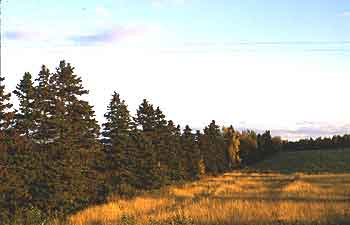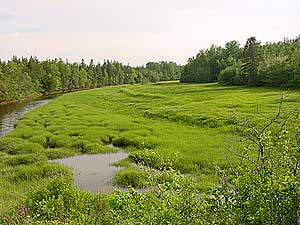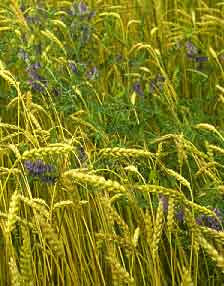CORRIDORS
Corridors are linear landscape features--such as streams, hedgerows, roads and roadside vegetation--(Foreman & Gordon 1986) which
link habitat patches together, facilitating population movement and flows of energy and materials across the landscape (Foreman 1995).
There are five functions of landscape corridors (Foreman 1995):
- Conduit: permits species and materials to move across the landscape. A stream, hedgerow or road are three examples.
- Barrier or Filter:prevents the movement of species and materials across the landscape. As with the above, a stream, hedgerow or road can also act as a barrier, depending upon the species in question. For instance, hedgerows not only prevent the movement of livestock, but also prevent wild animals from entering the farm site (Foreman & Gordon 1982).
- Habitat: provides habitat for species. Hedgerows can provide habitat for forest dwelling species. However, due to their narrow width, hedgerows are often only suitable for forest-edge species as opposed to interior-dwelling species which need a wider amount of habitat to survive. Due to this, hedgerows can be thought of as "the forest edge without the forest!" (Foreman 1995).
- Source: acts as a resevoir which PROVIDES both species and materials to the surrounding matrix. For example, a road can act as a source of chemicals, dust and amimals which move from the road into the matrix.
- Sink: acts as a resevoir which ABSORBS species and material from the surrounding matrix. An example would be seeds and soil particles which become trapped in a hedgerow.
Examples
| HEDGEROWS
A "living fence," hedgerows provide forage and shelter for livestock and function as important corridors for birds, mammals, reptiles, plants and insects. They can also alter wind and heat flows. Hedgerows can be particularly valuable in joining fragmented forest patches. They can protect the farm from soil, nutrient and water loss if they are planted parallel to the contours of sloping land. Hedgerows are generally best for wildlife when they consist of shrubs interspersed with large trees. (Burel 1996, van Mansvelt & van der Lubbe 1999). |
 A hedgerow on a P.E.I farm. Source: David Patriquin. |
STREAMS/RIPARIAN VEGETATION Streams can serve as an important corridor, connecting patches of riparian vegetation such as trees, shrubs and grasses located near the stream bank. Riparian vegetation may serve as a habitat patch or movement corridor for a species. Riparian vegetation protects the stream from sediment loading which may result from the soil erosion of unprotected riverbanks. This vegetation may also serve as a source of important nutrients which enter the stream, providing a nutrient source for species. (Agriculture Canada 2000, Foreman & Gordon 1986). |
 Acadian dykeland in Nova Scotia, established in the 1600's support native perennial grasses which protect the watercourse and provide hay. Source: David Patriquin. |
ROADS/ROADSIDE VEGETATION Larger mammals such as coyotes may use the road itself for travel whereas smaller mammals, insects and plants may use the roadside vegetation or "verge". Verges often have a high level of plant diversity which supports a colourful array of attractive wild flowers and grasses which provide habitat for species not able to survive in open fields. Verges can be threated by mowing, burning and chemical run-off from the road. Roads may acts as a barrier to some species by reducing the rate at which they cross roads. Roads can also affect the surrounding landscape matrix by acting as a source of dust, dirt and roadside chemicals (Foreman & Gordon 1986,Gulinck & Pauwels 2000). |
 A form of vetch (4 seed vetch,vicia tetrasperma). Found in crops, such as winter wheat, but can also be found along roadsides. Source: David Patriquin. |
Home Page